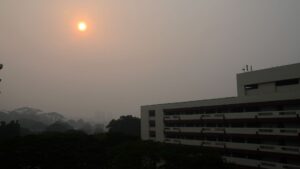Disguised pollution: Industrial activities in the dark
In this paper, we show that some Chinese firms, under the cover of darkness, emit increased amounts of sulfur dioxide (SO2). Using hourly pollution data from 1,583 national monitoring stations in China from January 2015 to December 2017, we found a significant increase in industrial toxin SO2 levels after sunset in highly industrialized areas. This insight enhances our understanding of industrial firms’ pollution practices. While these monitoring stations are strategically placed in heavily polluted industrial regions, nearby firms engage in covert pollution activities, taking advantage of the lack of direct government oversight, especially during nighttime hours. Our findings highlight the necessity for a more comprehensive environmental monitoring system, encompassing both daytime and nighttime operations and their associated toxic emissions. This system should extend its coverage beyond large corporations to include smaller firms in industrialized areas.
Startups’ demand for accounting expertise: evidence from a randomized field experiment
Gefen, O., Reeb, D. & Sulaeman, J. (2023) Startups’ demand for accounting expertise: evidence from a randomized field experiment. Review of Accounting Studies, https://doi.org/10.1007/s11142-023-09775-8
This paper examines whether startup companies prefer investors with accounting expertise. To test this, we conducted an experiment with over 13,000 startup companies in the US, sending them emails pretending to be interested investors, some with accounting certifications (CPA) and some without any special credentials. As a result, we found that the startups were more likely to respond to the emails from the investors with CPA certifications. This preference held even when the investors pretended to be different types of investors, such as angel investors or venture capitalists. This shows that startups value accounting expertise in their investors significantly. In a follow-up experiment, we found that startups preferred CPA-certified investors over those with a general business degree (MBA), reinforcing the importance of accounting expertise to them.
Expanding footprints: The impact of passenger transportation on corporate locations
Lin, Y., Qin, Y., Sulaeman, J., Yan, J., Zhang, J. (2023). Expanding footprints: The impact of passenger transportation on corporate locations. Review of Finance, 2023, 27, 1119–1154. https://doi.org/10.1093/rof/rfac049
Transportation plays a vital role in shaping where businesses thrive and grow. This study explores how making travel more convenient can help businesses expand into new areas and enhance communication between investors and companies. We focus on the effects of improving passenger travel in China through the High-Speed Rail (HSR) system. Using over 1 million firm-to-firm investment observations over the 12-year period, we find that when two cities are directly connected by HSR, the number of investments between them increases significantly by 8%, and the amount of investment grows by 45%. These results hold even when we account for differences between city pairs and local factors that might influence HSR route choices. Our results suggest that improved monitoring and access to information are essential drivers of the HSR’s effects.
Long-term effects of air pollution on Singapore’s national university admissions
Agarwal, S., Tan, P.L., Tan-Soo, J.S. (2023). Long-term effects of air pollution on Singapore’s national university admissions. Applied Economics Letters, 31(13), 1178-1183, https://doi.org/10.1080/13504851.2023.2177586
In this research, we examine the lasting effects of being exposed to haze pollution on university admissions in Singapore. Using the individual-level data from all university applicants in Singapore between 1981 and 2015, we discovered that people who were exposed to haze while in the womb during the episodes in April 1977 and October 1983 had lower admission scores and were less likely to get into university compared to those not exposed to haze. These effects were more pronounced for females. However, for the haze episodes in October 1991, August to October 1994, and August to October 1997, which were even more severe pollution events, we did not find the same negative impacts. These results show that air pollution’s long-term effects can vary. While the effects of the first two episodes lingered over time, the later three episodes suggest that negative impacts might be reduced due to economic progress and protective measures.
The effects of policy announcement, prices and subsidies on water consumption
Agarwal, S., Araral, E., Fan, M. , Yu, Q., Zheng, H. (2023) The effects of policy announcement, prices and subsidies on water consumption. Nat Water, 1, 176–186. https://doi.org/10.1038/s44221-023-00028-1
In our research, we investigate how alterations in water prices and subsidies influence water conservation in Singapore. Analyzing a decade of monthly billing data for 2.2 million residential accounts, we discovered that simply announcing a water price increase led to a 3.7% reduction in consumption, more impactful than the actual 30% price hike. Consumers who were more conscious of price changes responded more to the announcement, while those with higher water usage were more influenced by the actual price increase. Moreover, our research emphasizes that only through calibrated information provision and program design can we alleviate the financial burden on lower-income households’ water consumption while maintaining the positive water conservation effects resulting from a price increase. In summary, our results suggest that the traditional market-based policy instruments, such as price and subsidy, could be combined with “information salience” to achieve sustainable outcomes efficiently with minimal technology advancement cost.
Public media campaign and energy conservation: A natural experiment in Singapore
Agarwal, S., Sing, T.F., Sultana, M. (2022). Public media campaign and energy conservation: A natural experiment in Singapore. Energy Economics, 2022, 114 (106281), , https://doi.org/10.1016/j.eneco.2022.106281
Singapore uses public media campaigns to motivate public housing residents to conserve energy as part of its strategies to achieve sustainable energy goals. In this research, we aim to identify if these campaigns actually work in practice. Using the energy conservation campaign conducted in Singapore in January 2016, we found that in areas with the campaigns, people living in public housing used about 0.4% less electricity compared to those in places without the campaigns. We also discovered that this saving effect was not a one-time occurrence but has persisted even after the campaign. When we calculated its value in currency, we found that this program brought about S$350,000 in benefits for the people.
Water conservation through plumbing and nudging
Agarwal, S., Araral, E., Fan, M., Yu, Q., Zheng, H. (2022). Water conservation through plumbing and nudging. Nature Human Behaviour, 6, 858–867, https://doi.org/10.1038/s41562-022-01320-y
In this paper, we explore the effectiveness of two approaches in addressing urban water challenges: “plumbing upgrades” and “nudging.” Utilizing data from 1.5 million accounts in Singapore over ten years, we discovered that a nationwide Home Improvement Programme, designed to enhance plumbing efficiency, reduces residential water use by 3.5%. Moreover, upgrading plumbing enhances the effectiveness of other water-saving initiatives and proves beneficial during extreme weather conditions. While the cost savings on utility bills from plumbing upgrades may not be substantial, the rise in home values justifies the investment. However, a large-scale nudging program that encourages water conservation through peer comparison did not show clear evidence of reduced water use.
Impact of transboundary air pollution on service quality and consumer satisfaction
Agarwal, S., Long, W., Yang, Y. (2021). Impact of transboundary air pollution on service quality and consumer satisfaction. Journal of Economic Behavior and Organization, 192, 357-380, https://doi.org/10.1016/j.jebo.2021.10.002
This study investigates how air pollution in Singapore, stemming from forest fires in Indonesia, impacts both firm productivity and consumer satisfaction. We measured firm productivity in the private sector by examining subcategory review scores related to service quality, while consumer satisfaction was assessed through overall individual-level online review scores. Our findings indicate that when air quality declines due to haze, there is a noticeable dip in consumer satisfaction. However, as the haze clears, consumer satisfaction undergoes a significant recovery, remaining higher than pre-haze levels for approximately eight months. A deeper dive into the review data using sentiment analysis revealed that the decline in consumer satisfaction during hazy periods is more linked to changes in people’s mood rather than any decline in service quality.
Impact of temperature on morbidity: New evidence from China
Agarwal, S., Yu, Q,. Shi, L., Wei, G., Zhu, H. (2021). Impact of temperature on morbidity: New evidence from China. Journal of Environmental Economics and Management, 109(102495), https://doi.org/10.1016/j.jeem.2021.102495
In this study, we investigate how temperature impacts hospitalization rates in China. Utilizing medical data from two major public insurance programs across 47 cities and 28 provinces over three years, we found that when the average temperature exceeds 27°C, there is a 7.3% increase in hospital admissions and a 2% increase in hospitalizations over the subsequent weeks compared to normal temperature days. This effect is more pronounced than what has been observed in developed countries. We also calculated the financial impact of these temperature-related hospitalizations. Each additional hot day in China results in about 2 billion yuan (roughly 0.3 billion US dollars) in increased medical expenses, with 1.9 billion yuan (about 0.29 billion US dollars) covered by the public insurance system and 0.2 billion yuan (approximately 0.01 billion US dollars) paid by insured individuals. In simple terms, our study shows that hot weather significantly increases hospitalizations and healthcare costs in China, with most of the cost burden placed on the public insurance system.
The impact of transboundary haze pollution on household utilities consumption
Agarwal, S., Sing, T. F., & Yang, Y. (2020). The impact of transboundary haze pollution on household utilities consumption. Energy Economics, 85(104591), https://doi.org/10.1016/j.eneco.2019.104591
This paper investigates how air pollution impacts household water and electricity consumption in Singapore, using transboundary haze pollution from Indonesian forest fires as an external factor. Our findings reveal that heightened levels of haze pollutants in the air result in significant increases in water and electricity usage. This happens because, during severe haze periods, households tend to stay indoors, curtail outdoor activities to minimize health risks, and intensify efforts to mitigate these risks when necessary. Our analysis of social media data, particularly Twitter tweets, indicates that higher water and electricity consumption is associated with more negative emotions and perceptions of air pollution. The effects on utility consumption are also linked to the duration of air pollution, with short-term effects returning to normal quickly. However, longer periods of air pollution lead to sustained higher utility consumption for up to two months, reflecting increased spending on water and electricity due to air pollution events.
- « Previous
- 1
- 2
- 3
- Next »










